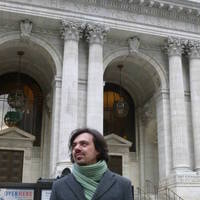Books by Andrew Peck
University of Wisconsin Press, 2023
Available at https://uwpress.wisc.edu/books/5998.htm
Edited Collection, published by Utah State University Press.
Contributors include: Sheila Bock, ... more Edited Collection, published by Utah State University Press.
Contributors include: Sheila Bock, Peter M. Broadwell, Bill Ellis, Jeana Jorgensen, Liisi Laineste, John Laudun, Linda J. Lee, Lynne S. McNeill, Ryan M. Milner, Whitney Phillips, Vwani Roychowdhury, Timothy R. Tangherlini, Tok Thompson, Elizabeth Tucker, Kristiana Willsey
Available via USU Press (https://upcolorado.com/utah-state-university-press/item/3892-folklore-and-social-media) and Amazon (https://www.amazon.com/Folklore-Social-Media-Andrew-Peck/dp/1646420586/ref=sr_1_1?dchild=1&keywords=%22Folklore+and+Social+Media%22&qid=1596223637&s=books&sr=1-1).
Articles by Andrew Peck
Journal of American Folklore, 2020
Available at: https://muse.jhu.edu/article/759033/pdf
This article argues that digital networks ... more Available at: https://muse.jhu.edu/article/759033/pdf
This article argues that digital networks have enabled fake news by amplification. Fake news by amplification occurs when small-scale events become amplified through the convergent actions of everyday users, mass media gatekeepers, and social media algorithms. Events that are amplified risk becoming distorted as they circulate, with users supplying their own context and interpretations. The resulting fake news is difficult to counter because it goes beyond questions of fact and enters the realm of interpretation, enabled by widespread, networked belief.
International Journal of Communication, 2020
Available at: https://ijoc.org/index.php/ijoc/article/view/10965/2947
This article examines the ... more Available at: https://ijoc.org/index.php/ijoc/article/view/10965/2947
This article examines the role of digitally mediated handmade signs in contemporary social movements. Bringing together theories of memetic practice, vernacular authority, and material traditions, we argue that vernacular materiality occurs wherever users turn to handmade, physical messages and material signifiers to transmit meaning online. Juxtaposing the humble and personalized aesthetics of handwritten messages against the polished, programmed, and virtual aesthetics of digital media, users mobilize vernacular materiality to disrupt hegemonic spaces and narratives by harnessing the affordances of physical and social media.
Cultural Analysis, 2017
Available at: https://www.ocf.berkeley.edu/~culturalanalysis/volume16/vol16_Peck.html
This artic... more Available at: https://www.ocf.berkeley.edu/~culturalanalysis/volume16/vol16_Peck.html
This article argues that networked digital media technologies enable vernacular practices to become both more mediated and more visible. Using the case of a popular digital legend known as “The Slender Man” to illustrate this argument, this article suggests that this increased visibility circulates awareness and encourages an open-source sense of collaboration. As users collaborate on creating and sharing vernacular practices, they begin to develop hierarchies of performance that privilege certain types of interaction, creating an atmosphere that facilitates vernacular critique. The result is that the digital age creates new possibilities for both the networked circulation of vernacular practice and for the meta-discursive interactions surrounding those practices.
Contemporary Legend, 2016
Journal of American Folklore, 2015
The faceless, tall, eerily long-limbed humanoid clad in a black suit emerged in an online forum a... more The faceless, tall, eerily long-limbed humanoid clad in a black suit emerged in an online forum as a pair of photoshops and a half-dozen lines of text. Soon, this so-called “Slender Man” began appearing in images, videos, stories, and blogs across the Internet. By sharing, discussing, and commenting on these artifacts using participatory media, users create legendary narratives and audio/visual “evidence” that present researchers with a new kind of digital folk practice. Enabled by the affordances of digital and social networks, this digital legend cycle serves as an example of a new form of digital folklore that combines the generic conventions of oral and visual storytelling with the collaborative potential of networked communication.
International Journal of Communication, 2014
Available at: https://ijoc.org/index.php/ijoc/article/view/2692/1155
This essay examines “photos... more Available at: https://ijoc.org/index.php/ijoc/article/view/2692/1155
This essay examines “photoshopping” as an important emerging genre of vernacular practice on the Internet. By sharing digitally altered images across networks, users engage in a vernacular process that creates and participates in discourses concerning shared expectations and communal values. To demonstrate this process, this essay analyzes how photoshopping was used as a response to the pepper-spraying of a group of peaceful protesters on theUniversityofCalifornia,Davis, campus. Enabled by the affordances of networked communication, this essay argues that photoshopping represents a powerful new form of vernacular expression for the digital age.
Book Chapters by Andrew Peck
Folklore and Social Media, 2020
Forthcoming
Folklore and Social Media, 2020
Slender Man Is Coming: Creepypastas and Contemporary Legends on the Internet, 2018
Presidential debates in a changing media environment—Volume II: The citizens talk back, 2018
In this chapter, I argue that Internet memes function as a mode of vernacular rhetoric that empow... more In this chapter, I argue that Internet memes function as a mode of vernacular rhetoric that empowers everyday users to respond to political campaigns and traditional media producers. Memetic practices enable networked users to repurpose and redeploy institutional media and narratives in a way that can hail institutional responses or set communicative agendas. Set in a liminal space between text and practice, these decentralized communications work together as a form of aggregate volition that gains power from imagining itself in alterity to institutional communication.
Hashtag Publics, 2015
This chapter approaches the #firstworldproblems controversy from the standpoint of contemporary h... more This chapter approaches the #firstworldproblems controversy from the standpoint of contemporary humor theory. Understanding how the discursive circulation of these textual fragments creates publicity means observing localized exchanges surrounding this humor and attending to variation and change over time (Warner, 2002, p. 420). Hence, this chapter adds to conversations surrounding publics, digital humor, and social media by drawing on the work of humor theorist Elliott Oring in order to suggest that analyzing how specific genres of humor—such as #firstworldproblems—function socially entails an attention to how various appropriate incongruities create, frame, and partake in
conversations about their subjects.











Uploads
Books by Andrew Peck
Contributors include: Sheila Bock, Peter M. Broadwell, Bill Ellis, Jeana Jorgensen, Liisi Laineste, John Laudun, Linda J. Lee, Lynne S. McNeill, Ryan M. Milner, Whitney Phillips, Vwani Roychowdhury, Timothy R. Tangherlini, Tok Thompson, Elizabeth Tucker, Kristiana Willsey
Available via USU Press (https://upcolorado.com/utah-state-university-press/item/3892-folklore-and-social-media) and Amazon (https://www.amazon.com/Folklore-Social-Media-Andrew-Peck/dp/1646420586/ref=sr_1_1?dchild=1&keywords=%22Folklore+and+Social+Media%22&qid=1596223637&s=books&sr=1-1).
Articles by Andrew Peck
This article argues that digital networks have enabled fake news by amplification. Fake news by amplification occurs when small-scale events become amplified through the convergent actions of everyday users, mass media gatekeepers, and social media algorithms. Events that are amplified risk becoming distorted as they circulate, with users supplying their own context and interpretations. The resulting fake news is difficult to counter because it goes beyond questions of fact and enters the realm of interpretation, enabled by widespread, networked belief.
This article examines the role of digitally mediated handmade signs in contemporary social movements. Bringing together theories of memetic practice, vernacular authority, and material traditions, we argue that vernacular materiality occurs wherever users turn to handmade, physical messages and material signifiers to transmit meaning online. Juxtaposing the humble and personalized aesthetics of handwritten messages against the polished, programmed, and virtual aesthetics of digital media, users mobilize vernacular materiality to disrupt hegemonic spaces and narratives by harnessing the affordances of physical and social media.
This article argues that networked digital media technologies enable vernacular practices to become both more mediated and more visible. Using the case of a popular digital legend known as “The Slender Man” to illustrate this argument, this article suggests that this increased visibility circulates awareness and encourages an open-source sense of collaboration. As users collaborate on creating and sharing vernacular practices, they begin to develop hierarchies of performance that privilege certain types of interaction, creating an atmosphere that facilitates vernacular critique. The result is that the digital age creates new possibilities for both the networked circulation of vernacular practice and for the meta-discursive interactions surrounding those practices.
This essay examines “photoshopping” as an important emerging genre of vernacular practice on the Internet. By sharing digitally altered images across networks, users engage in a vernacular process that creates and participates in discourses concerning shared expectations and communal values. To demonstrate this process, this essay analyzes how photoshopping was used as a response to the pepper-spraying of a group of peaceful protesters on theUniversityofCalifornia,Davis, campus. Enabled by the affordances of networked communication, this essay argues that photoshopping represents a powerful new form of vernacular expression for the digital age.
Book Chapters by Andrew Peck
conversations about their subjects.
Contributors include: Sheila Bock, Peter M. Broadwell, Bill Ellis, Jeana Jorgensen, Liisi Laineste, John Laudun, Linda J. Lee, Lynne S. McNeill, Ryan M. Milner, Whitney Phillips, Vwani Roychowdhury, Timothy R. Tangherlini, Tok Thompson, Elizabeth Tucker, Kristiana Willsey
Available via USU Press (https://upcolorado.com/utah-state-university-press/item/3892-folklore-and-social-media) and Amazon (https://www.amazon.com/Folklore-Social-Media-Andrew-Peck/dp/1646420586/ref=sr_1_1?dchild=1&keywords=%22Folklore+and+Social+Media%22&qid=1596223637&s=books&sr=1-1).
This article argues that digital networks have enabled fake news by amplification. Fake news by amplification occurs when small-scale events become amplified through the convergent actions of everyday users, mass media gatekeepers, and social media algorithms. Events that are amplified risk becoming distorted as they circulate, with users supplying their own context and interpretations. The resulting fake news is difficult to counter because it goes beyond questions of fact and enters the realm of interpretation, enabled by widespread, networked belief.
This article examines the role of digitally mediated handmade signs in contemporary social movements. Bringing together theories of memetic practice, vernacular authority, and material traditions, we argue that vernacular materiality occurs wherever users turn to handmade, physical messages and material signifiers to transmit meaning online. Juxtaposing the humble and personalized aesthetics of handwritten messages against the polished, programmed, and virtual aesthetics of digital media, users mobilize vernacular materiality to disrupt hegemonic spaces and narratives by harnessing the affordances of physical and social media.
This article argues that networked digital media technologies enable vernacular practices to become both more mediated and more visible. Using the case of a popular digital legend known as “The Slender Man” to illustrate this argument, this article suggests that this increased visibility circulates awareness and encourages an open-source sense of collaboration. As users collaborate on creating and sharing vernacular practices, they begin to develop hierarchies of performance that privilege certain types of interaction, creating an atmosphere that facilitates vernacular critique. The result is that the digital age creates new possibilities for both the networked circulation of vernacular practice and for the meta-discursive interactions surrounding those practices.
This essay examines “photoshopping” as an important emerging genre of vernacular practice on the Internet. By sharing digitally altered images across networks, users engage in a vernacular process that creates and participates in discourses concerning shared expectations and communal values. To demonstrate this process, this essay analyzes how photoshopping was used as a response to the pepper-spraying of a group of peaceful protesters on theUniversityofCalifornia,Davis, campus. Enabled by the affordances of networked communication, this essay argues that photoshopping represents a powerful new form of vernacular expression for the digital age.
conversations about their subjects.